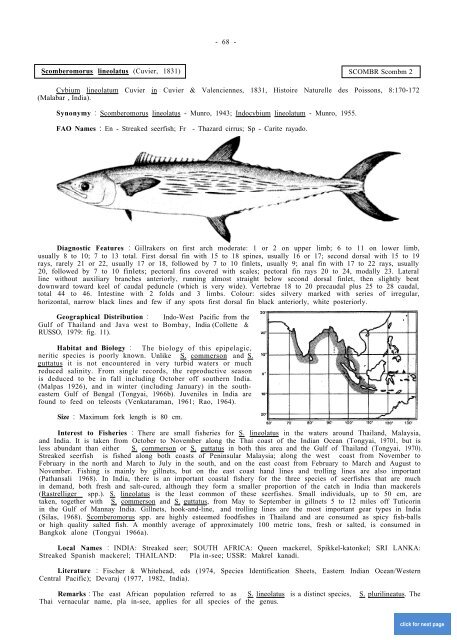FAO SPECIES CATALOGUE - si-pddr
FAO SPECIES CATALOGUE - si-pddr
FAO SPECIES CATALOGUE - si-pddr
Create successful ePaper yourself
Turn your PDF publications into a flip-book with our unique Google optimized e-Paper software.
Scomberomorus lineolatus (Cuvier, 1831)<br />
- 68 -<br />
Cybium lineolatum Cuvier in Cuvier & Valenciennes, 1831, Histoire Naturelle des Poissons, 8:170-172<br />
(Malabar , India).<br />
Synonymy : Scomberomorus lineolatus - Munro, 1943; Indocybium lineolatum - Munro, 1955.<br />
<strong>FAO</strong> Names : En - Streaked seerfish; Fr - Thazard cirrus; Sp - Carite rayado.<br />
Diagnostic Features : Gillrakers on first arch moderate: 1 or 2 on upper limb; 6 to 11 on lower limb,<br />
usually 8 to 10; 7 to 13 total. First dorsal fin with 15 to 18 spines, usually 16 or 17; second dorsal with 15 to 19<br />
rays, rarely 21 or 22, usually 17 or 18, followed by 7 to 10 finlets, usually 9; anal fin with 17 to 22 rays, usually<br />
20, followed by 7 to 10 finlets; pectoral fins covered with scales; pectoral fin rays 20 to 24, modally 23. Lateral<br />
line without auxiliary branches anteriorly, running almost straight below second dorsal finlet, then slightly bent<br />
downward toward keel of caudal peduncle (which is very wide). Vertebrae 18 to 20 precaudal plus 25 to 28 caudal,<br />
total 44 to 46. Intestine with 2 folds and 3 limbs. Colour: <strong>si</strong>des <strong>si</strong>lvery marked with series of irregular,<br />
horizontal, narrow black lines and few if any spots first dorsal fin black anteriorly, white posteriorly.<br />
Geographical Distribution : Indo-Westt Pacific from the<br />
Gulf of Thailand and Java west to Bombay, India (Collette &<br />
RUSSO, 1979: fig. 11).<br />
Habitat and Biology : The biology of this epipelagic,<br />
neritic species is poorly known. Unlike S. commerson and S.<br />
guttatus it is not encountered in very turbid waters or much<br />
reduced salinity. From <strong>si</strong>ngle records, the reproductive season<br />
is deduced to be in fall including October off southern India.<br />
(Malpas , 1926), and in winter (including January) in the south-<br />
eastern Gulf of Bengal (Tongyai, 1966b). Juveniles in India are<br />
found to feed on teleosts (Venkataraman, 1961; Rao, 1964).<br />
Size : Maximum fork length is 80 cm.<br />
SCOMBR Scombm 2<br />
Interest to Fisheries : There are small fisheries for S. lineolatus in the waters around Thailand, Malay<strong>si</strong>a,<br />
and India. It is taken from October to November along the Thai coast of the Indian Ocean (Tongyai, 19701, but is<br />
less abundant than either S. commerson or S. guttatus in both this area and the Gulf of Thailand (Tongyai, 1970).<br />
Streaked seerfish is fished along both coasts of Peninsular Malay<strong>si</strong>a; along the west coast from November to<br />
February in the north and March to July in the south, and on the east coast from February to March and August to<br />
November. Fishing is mainly by gillnets, but on the east coast hand lines and trolling lines are also important<br />
(Pathansali, 1968). In India, there is an important coastal fishery for the three species of seerfishes that are much<br />
in demand, both fresh and salt-cured, although they form a smaller proportion of the catch in India than mackerels<br />
(Rastrelligerrr spp.). S. lineolatus is the least common of these seerfishes. Small individuals, up to 50 cm, are<br />
taken, together with S. commerson and S. guttatus, from May to September in gillnets 5 to 12 miles off Tuticorin<br />
in the Gulf of Mannay India. Gillnets, hook-and-line,, and trolling lines are the most important gear types in India<br />
(Silas, 1968). Scomberomorus spp. are highly esteemed foodfishes in Thailand and are consumed as spicy fish-balls<br />
or high quality salted fish. A monthly average of approximately 100 metric tons, fresh or salted, is consumed in<br />
Bangkok alone (Tongyai 1966a).<br />
Local Names : INDIA: Streaked seer; SOUTH AFRICA: Queen mackerel, Spikkel-katonkel; SRI LANKA:<br />
Streaked Spanish mackerel; THAILAND: Pla in-see; USSR: Makrel kanadi.<br />
Literature : Fischer & Whitehead, eds (1974, Species Identification Sheets, Eastern Indian Ocean/Western<br />
Central Pacific); Devaraj (1977, 1982, India).<br />
Remarks : The east African population referred to as S. lineolatus is a distinct species, S. plurilineatus. The<br />
Thai vernacular name, pla in-see, applies for all species of the genus.<br />
click for next page
















